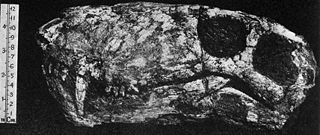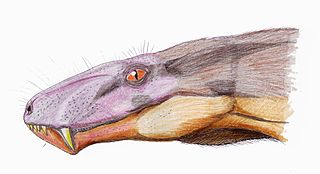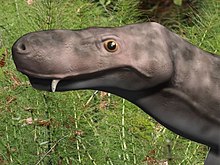
Psittacosaurus is a genus of extinct ceratopsian dinosaur from the Early Cretaceous of what is now Asia, existing between 125 and 105 million years ago. It is notable for being the most species-rich non-avian dinosaur genus. Up to 12 species are known, from across China, Mongolia, Russia, and Thailand. The species of Psittacosaurus were obligate bipeds at adulthood, with a high skull and a robust beak. One individual was found preserved with long filaments on the tail, similar to those of Tianyulong. Psittacosaurus probably had complex behaviours, based on the proportions and relative size of the brain. It may have been active for short periods of time during the day and night, and had well-developed senses of smell and vision.

Gryposaurus was a genus of duckbilled dinosaur that lived about 80 to 75 million years ago, in the Late Cretaceous of North America. Named species of Gryposaurus are known from the Dinosaur Park Formation in Alberta, Canada, and two formations in the United States: the Lower Two Medicine Formation in Montana and the Kaiparowits Formation of Utah. A possible additional species from the Javelina Formation in Texas may extend the temporal range of the genus to 66 million years ago.

Gorgonops is an extinct genus of gorgonopsian therapsid, of which it is the type genus. Gorgonops lived during the Late Permian (Wuchiapingian), about 260–254 million years ago in what is now South Africa.

Inostrancevia is an extinct genus of large carnivorous therapsids which lived during the Late Permian in what is now European Russia and Southern Africa. The first-known fossils of this gorgonopsian were discovered in the context of a long series of excavations carried out from 1899 to 1914 in the Northern Dvina, Russia. Among these are two near-complete skeletons embodying the first described specimens of this genus. It is also the first gorgonopsian identified in Russia. Several other fossil materials were discovered there, and the various finds led to confusion as to the exact number of valid species, before only two of them were formally recognized, namely I. alexandri and I. latifrons. A third species, I. uralensis, was erected in 1974, but the fossil remains of this taxon are very thin and could come from another genus. More recent research carried out in South Africa aand Tanzania has discovered specimens identified as belonging to this genus, with the South African specimens being classified within the species I. africana. The whole genus is named in honor of Alexander Inostrantsev, professor of Vladimir P. Amalitsky, the paleontologist who described the taxon.

Lycaenops ("wolf-face") is a genus of carnivorous therapsids. It lived during the Middle Permian to the early Late Permian, about 260 mya, in what is now South Africa.

Dinogorgon is a genus of gorgonopsid from the Late Permian of South Africa and Tanzania. The generic name Dinogorgon is derived from Greek, meaning "terrible gorgon", while its species name rubidgei is taken from the surname of renowned Karoo paleontologist, Professor Bruce Rubidge, who has contributed to much of the research conducted on therapsids of the Karoo Basin. The type species of the genus is D. rubidgei.

Sauroctonus is an extinct genus of gorgonopsian therapsids who lived during the end of the Middle Permian in what is now European Russia. The first fossils, discovered in Tatarstan, were initially believed to belong to a new species of the South African genus Arctognathus. The taxon was designated as such until 1940, when it was assigned to the genus Inostrancevia by Ivan Yefremov, before being definitively classified in a separate genus erected by Alexey Bystrow. The most complete, known fossils of S. progressus include cranial and postcranial elements, currently all recorded from Tatarstan. These elements show that the animal was a mid-sized gorgonopsian.

The Belum Caves, located in Nandyala district of Andhra Pradesh's Rayalaseema region, is the second largest cave system on the Indian subcontinent, known for its speleothems, such as stalactite and stalagmite formations. The Belum Caves have long passages, galleries, spacious caverns with fresh water and siphons. This cave system was formed over the course of tens of thousands of years by the constant flow of underground water from the now-disappeared river Chitravathi. The cave system reaches its deepest point at the point known as Pataalaganga. Belum Caves have a length of 3,229 m (10,593.8 ft), making them the second largest caves on the Indian Subcontinent after the Krem Liat Prah caves in Meghalaya. It is one of the centrally protected Monuments of National Importance.

Arctops is an extinct genus of gorgonopsian therapsids known from the Late Permian of South Africa. It measured up to 2 metres in length and its skull was 30 centimetres (12 in) long. The type species is Arctops willistoni. A second species, A. watsoni, may be synonymous with A. willistoni. A. kitchingi may be a third species of Arctops, but it was only tentatively assigned to the genus when it was first named. Both were formally synonymized with A. willistoni by Christian Kammerer in 2017.

Arctognathus is an extinct genus of gorgonopsids that throve during the Late Permian in the Karoo basin of what is now South Africa.

Aelurognathus is an extinct genus of gorgonopsian therapsids from the Permian of South Africa and Zambia.

Cyonosaurus is a genus of gorgonopsian therapsids from the late Permian of South Africa. Some skulls have been reported from Early Triassic strata, but further investigation revealed that these reports were erroneous. Cyonosaurus was 0.6 to 1.1 metres in length, with a skull 9 to 18 centimetres in length. The type species Cyonosaurus longiceps was named in 1937.

Aelurosaurus is a small, carnivorous, extinct genus of gorgonopsian therapsids from the Late Permian of South Africa. It was discovered in the Karoo Basin of South Africa, and first named by Richard Owen in 1881. It was named so because it appeared to be an ancestor for cat-like marsupials, but not yet a mammal itself. It contains five species, A. felinus, A. whaitsi, A. polyodon, A. wilmanae, and A.? watermeyeri. A. felinus, the type species, is generally well described with established features, while the other four species are not due to their poorly preserved holotypes.

Broomisaurus is an extinct genus of Gorgonopsia. It was first named by Joleaud in 1920, and contains the single species B. planiceps. Gebauer (2007) considered Broomisaurus to be a nomen dubium, indistinguishable as a separate taxon of gorgonopsian because it is based on only a fragmentary remains. A 2015 paper on Eriphostoma tentatively agreed with Gebauer's determination, but did not rule out the possibility that Broomisaurus might be synonymous with Eriphostoma.
Cerdorhinus is an extinct genus of gorgonopsian therapsids from the Permian of South Africa. The type species Cerdorhinus parvidens was named by South African paleontologist Robert Broom in 1936. A second species, Cerdorhinus rubidgei, was named in 1937. In 2007, a specimen of the latter was reassigned to the genus Cyonosaurus.

Geikia is an extinct genus of dicynodont therapsids from the late Permian. The abundance and diversity of dicynodonts during this period, combined with incomplete or inadequately prepared specimens, have led to challenges in determining relationships within this taxon. Only two species, Geikia locusticeps and Geikia elginensis have been assigned to this genus. While this is the currently accepted classification, fossil record limitations have led to repeated debate on the genus assignments of these species.
Rhabdognathus is an extinct genus of dyrosaurid crocodylomorph. It is known from rocks dating to the Paleocene epoch from western Africa, and specimens dating back to the Maastrichtian era were identified in 2008. It was named by Swinton in 1930 for a lower jaw fragment from Nigeria. The type species is Rhabdognathus rarus. Stéphane Jouve subsequently assessed R. rarus as indeterminate at the species level, but not at the genus level, and thus dubious. Two skulls which were assigned to the genus Rhabdognathus but which could not be shown to be identical to R. rarus were given new species: R. aslerensis and R. keiniensis, both from Mali. The genus formerly contained the species Rhabdognathus compressus, which was reassigned to Congosaurus compressus after analysis of the lower jaw of a specimen found that it was more similar to that of the species Congosaurus bequaerti. Rhabdognathus is believed to be the closest relative to the extinct Atlantosuchus.
"Dixeya" nasuta is a extinct species of gorgonopsian that lived during the Late Permian of East Africa, known from fossils found in what is now Tanzania. The species has a complicated taxonomic history, it was originally named as a second species of the genus Dixeya which is now considered a junior synonym of Aelurognathus. "D." nasuta itself, however, was not moved to Aelurognathus, and although it was instead tentatively referred to Arctognathus at first it has since been recognised to not belong to this genus either. This situation leaves "Dixeya" nasuta without a formal genus name. It was proposed to belong to a new distinct genus, named "Njalila", that was informally proposed for the species in a PhD thesis, but this name has not yet been formally published and is currently a nomen nudum. "D." nasuta has been characterised from other gorgonopsians by a combination of its straight snout profile, upturned and "pinched" nose, and curved jaw margin. The fossil record of the Usili Formation shows that the taxon was contemporary with many other gorgonopsians, even alongside large representatives such as Inostrancevia and rubidgeines.
Azabbaremys is an extinct genus of bothremydid pleurodiran turtle that was discovered in the Teberemt Formation of Mali. It was described in 2001, based on a skull that had been recovered in an expedition in 1981. The genus consists solely of the type species Azabbaremys moragjonesi. The genus name is derived from Azabbar, a monster in Tamasheq folk stories. The species is named for Morag Jones, a research student who participated in the discovery of the specimen and died in the expedition. Azabbaremys is most closely related to another Paleocene side-necked turtle, Acleistochelys.

Homo longi is an extinct species of archaic human identified from a nearly complete skull, nicknamed 'Dragon Man', from Harbin on the Northeast China Plain, dating to at minimum 146,000 years ago during the Middle Pleistocene. The skull was discovered in 1933 along the Songhua River while the Dongjiang Bridge was under construction for the Manchukuo National Railway. Due to a tumultuous wartime atmosphere, it was hidden and only brought to paleoanthropologists in 2018. H. longi has been hypothesized to be the same species as the Denisovans, but this cannot be confirmed without genetic testing.



















